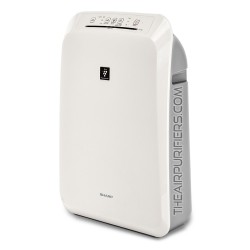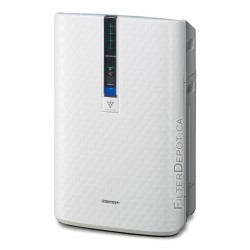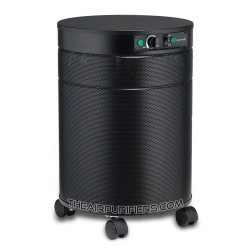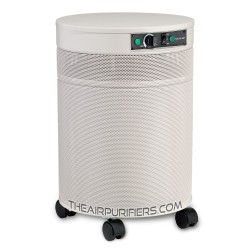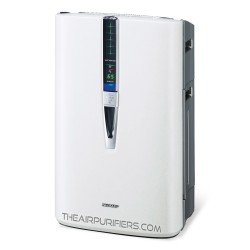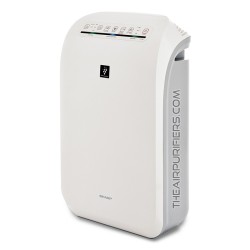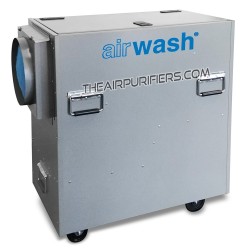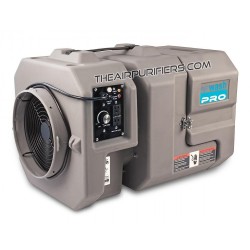No products
Air Purifiers for Pathogens
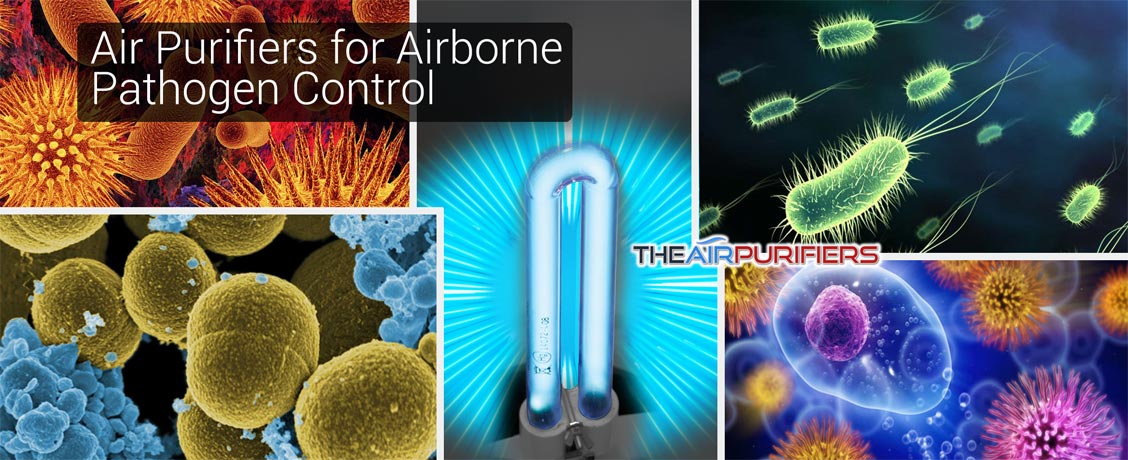
Health Risks of Pathogens (viruses, microbes, bacteria, germs)
Pathogens are infectious microorganisms or agents such as viruses (including coronaviruses), bacteria, microbes, germs, fungus (fungi). While the vast majority of bacteria are harmless or even beneficial to humans, some pathogenic bacteria, microbes and viruses are highly prone to cause globally significant infectious diseases such as tuberculosis, pneumonia, SARS and now COVID-19 (caused by SARS-CoV-2 coronavirus).
The other infectious diseases caused by viral pathogens include:
|
|
Although many pathogenic microorganisms primarily spread through a direct contact, due to a very small size and weight they can easily become airborne when the infected person spreads the pathogens through breathing or respiratory droplets expelled from the mouth and nose while sneezing and coughing.
Size of Pathogens:
- Bacteria: 1 - 5 micron
- Fungi: 1 - 40 micron
- Viruses: 0.02 - 0.3 micron
- SARS-CoV-2: ~ 0.12 micron
Pathogen Remediation
While pathogens are constantly present in the air, their type and concentration can be especially dangerous for children, individuals who have chronic asthma or other respiratory impairments, or those with preexisting respiratory ailments such as COPD, bronchitis, emphysema.
Effective removal of airborne pathogens out of the air can help significantly reduce the occurrence of infectious diseases caused by pathogenic microbes, bacteria and viruses and for these groups of people may become a life saving requirement.
There are few ways to suppress (kill) pathogens by subjecting them to:
- Chemicals (bleach, antibiotics)
- Ultraviolet light
- High temperature
- Mechanical air filtration
- Plasma (Ionization)
Exposure to Chemicals (bleach, antibiotics)
Many chemicals commonly named "bleach" containing chlorine based (sodium hypochlorite), peroxide based (hydrogen peroxide) and others are known to have a broad spectrum of bactericidal (anti-bacterial) properties and, therefore can be effectively used for disinfecting and sterilizing the surfaces and control viruses, bacteria, microbes in places where sterile conditions are required. The effectiveness of bleaches is attributed to their chemical reactivity against organic compounds, including protein. They irreversibly destroy many proteins, which makes them extremely versatile disinfectants.
The antibiotics is the most common method of killing bacteria, microbes, viruses. The antibiotics work by destroying the bacteria cell wall, which leads to expulsion of pathogen's DNA, inability of pathogens to produce proteins and eventually death. The antibiotics can be added into the air using vaporizers or humidifiers with medicine cup. Unfortunately, the recent studies show the emergence and spreading of "superbugs" which develop high level of resistance to selective inhibitory or toxic actions of antibiotics, making them ineffective.
Exposure to UV Light
The Ultraviolet (UV) light (Germicidal UV light especially) is the fastest and most effective way to disinfect and sterilize the air from airborne pathogens. The Germicidal UV bulb produces the ultraviolet light (UVC) with a specific wavelength of 253.7 nm (nanometer). The exposure of pathogens to the UV light of this wavelength destroys the Thymine amino acid in pathogen's DNA, leading to pathogen's inability to produce protein and resulting in death.
The sterilization power of Germicidal UV light is about 1,600 times of a direct sunlight, and therefore is extremely lethal to most airborne pathogens - viruses, bacteria, microbes.
Multiple tests show the utmost effectiveness of Germicidal UV bulb in fast and thorough sterilization of the air from airborne pathogens.
Below is the Pathogen Reduction Rate for Germicidal UV Bulb.
| Pathogen Type | Pathogens | Rate of Reduction |
| Bacteria | Escherichia Coli (E.Coli) | > 99.99% |
| Staphylococcus albus | > 99.99% | |
| Streptococcus | > 99.00% | |
| Mold, Fungus | Penicillium Citrinum | > 98.00% |
| Aspergillus Niger | > 97.8% | |
| Virus | MS2 Viral Stimulant | > 98.82% |
Exposure to High Temperature
Exposure to high temperature is another common method of deactivating pathogens and antigens. However, it is only applicable to killing pathogens attached to the surface of the objects required sterilization, and hence do nothing with the airborne pathogens, unless the entire volume of air is heated to high temperature, at which pathogens' proteins are destroyed.
Mechanical Air Filtration
True HEPA filter has a guaranteed filtration efficiency of over 99.97% in trapping all solid sub-micron airborne particulates as small as down to 0.3 micron in size. This size range includes all airborne bacteria, microbes, fungi and larger size viruses. Trapped in the air purifier's True HEPA filter, pathogens are exposed to the constant air rush, which deprives them of moisture and eventually making them to die of dehydration.
The higher efficiency particle filters such as, 99.99% @ 0.3 micron efficiency Super HEPA or 99.999% @ 0.1 micron efficiency ULPA filters can be more effective in trapping sub-micron viruses. However, tighter particulate filters, especially ULPA filter, may reduce the air flow and a number of air changes per hour (ACH), resulting in a lower overall performance due to a higher back pressure from a more dense filter media. Therefore, it is essential that the air filtration system of air purifiers for airborne pathogen control contains large and perfectly sealed True HEPA, Super HEPA or ULPA filter.
Plasma Ionization
In the early 2000s SHARP corporation developed and patented an advanced air cleaning technology called Plasmacluster Ion (PCI).
This innovative technology replicates Nature's Own air cleaning process that purifies air in the Earth's atmosphere by producing the balanced shower of positive and negative ions from water vapors in the air.
The ions are dispersed throughout the entire room where they actively seek, attack and deactivate airborne pathogens: germs, bacteria, viruses, mold spores, fungi, etc. Plasmacluster Ion technology also helps neutralize chemicals and reduce allergens and dust in the air.
The Sharp's Exclusive Plasmacluster Ion technology has clinically proven effective in significantly reducing the airborne pathogens such as:
Below is the Plasmacluster Ion Performance Test Results on Pathogens.
| Pathogen Type | Pathogens | Rate of Reduction |
| Bacteria | E.Coli | 94% |
| Staphylococcus Epidermis | 89.7% | |
| Serratia Marsescens | 85.6% | |
| Mold, Fungus | Penicillium Citrinum | 87.7% |
| Aspergillus Niger | 85.8% | |
| Virus | MS2 Viral Stimulant | 90.3% |
The series of experiments conducted by testing institute in Japan demonstrates that Sharp's Plasmacluster Ion technology (PCI) has the ability to reduce mold, fungus by 90% in just one hour.
Removal of Airborne Pathogens
In view of the above, the most efficient air purifiers for Airborne Pathogens Control should meet few requirements.
1. The air filtration system should include large and perfectly sealed particle filter: True HEPA, Super HEPA or ULPA.
While all air purifiers offered in this page are equipped with large True HEPA filters, two of them AirPura I600 and Amaircare 3000 employ the oversize True HEPA filter each containing a whopping 100 sq. ft. of medical grade True HEPA filter.
2. Germicidal UV bulb most likely is a single most effective option that can significantly boost the air purifier's ability to sterilize the air from airborne pathogens quickly and effectively.
AirPura UV600, AirPura P600, AirPura P600 Plus air purifier models all are equipped with high-output Germicidal UV bulb, making them the strongest contenders in the category of the most efficient air purifiers for Airborne Pathogens Control.
3. Sharp FP-F50UW, Sharp FP-F60UW, Sharp KC-850U and Sharp KC-860U all are equipped with Sharp's exclusive proprietary Plasmacluster Ion generators, and therefore are strong contenders in the category of best air purifiers for Airborne Pathogens Control.
Recommended Air Purifiers for Pathogens
Home and Office Use under 700 sq. ft.
Sharp FP-F50UW (FPF50UW) PCI Air Purifier for Medium Room
Sharp FP-F50UW (FPF50UW) PCI the compact Sharp air purifier features Sharp FP-F50UW 2-in-1 HEPA and Carbon filter and Sharp Plasmacluster Ion generator for effective medium room air purification.
US$219.99 US$249.99Out of stockSharp KC-850U (KC850U) PCI Air Purifier / Humidifier / Sterilizer
Sharp KC-850U (KC850U) PCI combines Sharp Plasmacluster Ion generator with Sharp KC-850U HEPA and Carbon filters and the exclusive humidifying function to purify, humidify and sterilize the air in large room quietly and efficiently.
US$443.99 US$523.99Sharp KC-850U (KC850U) in STOCK
Home and Office Use under 2000 sq. ft.
| Air Purifier Model | HEPA Filter, sq. ft. | Sterilization mechanism | Air Flow Rate, cfm |
| Airpura UV600 | 40 | Germicidal UV Bulb | 560 |
| Airpura P600 | 40 | Germicidal UV Bulb | 560 |
| Sharp KC-860U | 20 | Plasmacluster Ion | 300 |
| Sharp FP-F60UW | 17 | Plasmacluster Ion | 260 |
AirPura UV600 fitted with AirPura UV600 Germicidal Ultraviolet (UV) bulb achieves a superior rate of airborne pathogen suppression which makes the AirPura UV600 indispensable air purifier for individuals with severe respiratory impairments and illnesses. AirPura P600 Air Purifier integrates the AirPura P600 Photocatalytic Oxidation unit with AirPura P600 HEPA and Carbon filters to deliver the most comprehensive air purification among all AirPura air purifiers. Sharp KC-860U (KC860U) PCI air purifier combines Sharp air treatment technologies which enable Sharp KC-860U effectively purify, humidify and sterilize the air in very large rooms quietly, fully automatically at a minimal cost. Sharp FPF60UW (FP-F60UW) PCI air purifier employs Sharp FPF60UW True HEPA and Carbon filters along with Sharp PCI (Plasmacluster Ion) generator to provide effective large room air purification. AirPura UV600 Airborne Pathogen Suppression Air Purifier
AirPura P600 Photocatalytic Oxidation Air Purifier
Sharp KC-860U (KC860U) PCI Air Purifier / Humidifier / Sterilizer
Sharp FPF60UW (FP-F60UW) PCI Air Purifier for Large Room
Commercial and Business Use over 3000 sq. ft.
| Air Purifier Model | HEPA Filter, sq. ft. | Carbon Filter, lbs. | Air Flow Rate, cfm |
| Amaircare AirWash MultiPro BOSS | 100 x 2 | 6.5 lbs. VOC Canister x 2 | 2500 |
| Amaircare 7500 Cart | 100 x 2 | 6.5 lbs. VOC Canister x 2 | 1400 |
| Amaircare 6000V Cart | 100 | 6.5 lbs. VOC Canister | 800 |
| Amaircare AirWash MultiPro | 80 | 5.5 lbs. VOC Canister | 1300 |
Amaircare AirWash MultiPro BOSS AH2000 Heavy Duty Commercial Air Purifier with double capacity of Amaircare AirWash MultiPro and the AirWash MultiPro BOSS Dual motor/fan system is the most powerful and versatile Amaircare Heavy duty air purifier for commercial and industrial applications. Amaircare 7500 AirWash Cart Extra powerful Heavy duty Amaircare air purifier features the Amaircare 7500 AirWash Cart Dual air filtration systems making Amaircare 7500 AirWash Cart the ultimate Super Heavy duty air purifier.Discontinued! Get AirWash MultiPro BOSS instead. Amaircare 6000V AirWash Cart is the Amaircare Heavy Duty Cart mounted air purifier with the Amaircare 6000V HEPA and Carbon filters for a wide variety of commercial, institutional and industrial air cleaning applications.Discontinued! Get AirWash MultiPro or AirWash MultiPro BOSS instead. Amaircare AirWash MultiPro featuring the Amaircare AirWash MultiPro customizable filters, the Amaircare powerful fan and the Amaircare AirWash MultiPro unique modular stackable design is an ideal Heavy duty contractors air scrubber air purifier. Amaircare AirWash MultiPro BOSS AH2000 Heavy Duty Commercial Air Purifier
Amaircare 7500 AirWash Cart Super Heavy Duty Air Purifier
Amaircare 6000V AirWash Cart Heavy Duty Air Purifier
Amaircare AirWash MultiPro Heavy Duty Contractors Air Scrubber Air Purifier


